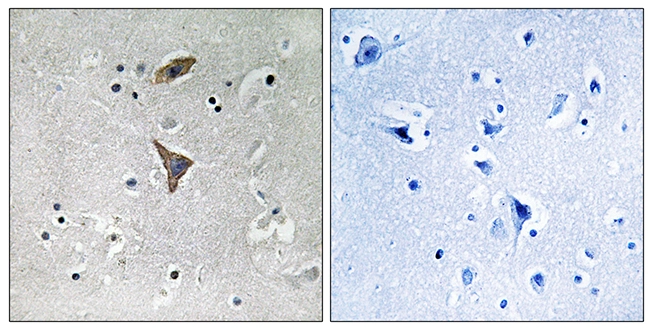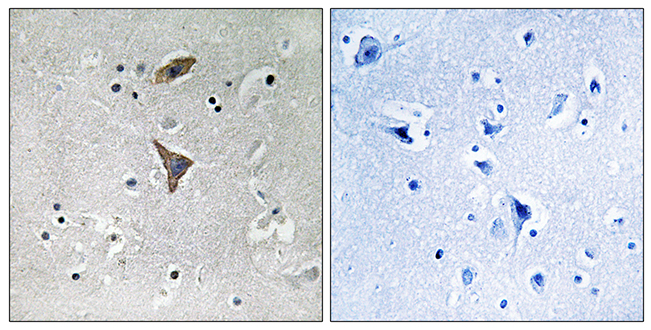
IHC-P analysis of human brain tissue using GTX87812 KCNT1 antibody. The picture on the right is blocked with the synthesized peptide.
KCNT1 antibody
GTX87812
ApplicationsImmunoHistoChemistry, ImmunoHistoChemistry Paraffin
Product group Antibodies
TargetKCNT1
Overview
- SupplierGeneTex
- Product NameKCNT1 antibody
- Delivery Days Customer9
- Application Supplier NoteIHC-P: 1:50~1:100. *Optimal dilutions/concentrations should be determined by the researcher.Not tested in other applications.
- ApplicationsImmunoHistoChemistry, ImmunoHistoChemistry Paraffin
- CertificationResearch Use Only
- ClonalityPolyclonal
- ConjugateUnconjugated
- Gene ID57582
- Target nameKCNT1
- Target descriptionpotassium sodium-activated channel subfamily T member 1
- Target synonymsbA100C15.2; DEE14; EIEE14; ENFL5; KCa4.1; potassium channel subfamily T member 1; potassium channel, sodium activated subfamily T, member 1; potassium channel, subfamily T, member 1; Sequence like a calcium-activated K+ channel; SLACK; Slo2.2
- HostRabbit
- IsotypeIgG
- Protein IDQ5JUK3
- Protein NamePotassium channel subfamily T member 1
- Scientific DescriptionPotassium channels represent the most complex class of voltage-gated ion channels from both functional and structural standpoints. Their diverse functions include regulating neurotransmitter release, heart rate, insulin secretion, neuronal excitability, epithelial electrolyte transport, smooth muscle contraction, and cell volume. This gene encodes a sodium-activated potassium channel subunit which is thought to function in ion conductance and developmental signaling pathways. Mutations in this gene cause the early-onset epileptic disorders, malignant migrating partial seizures of infancy and autosomal dominant nocturnal frontal lobe epilepsy. Alternative splicing results in multiple transcript variants. [provided by RefSeq, Dec 2012]
- Storage Instruction-20°C or -80°C,2°C to 8°C
- UNSPSC12352203





